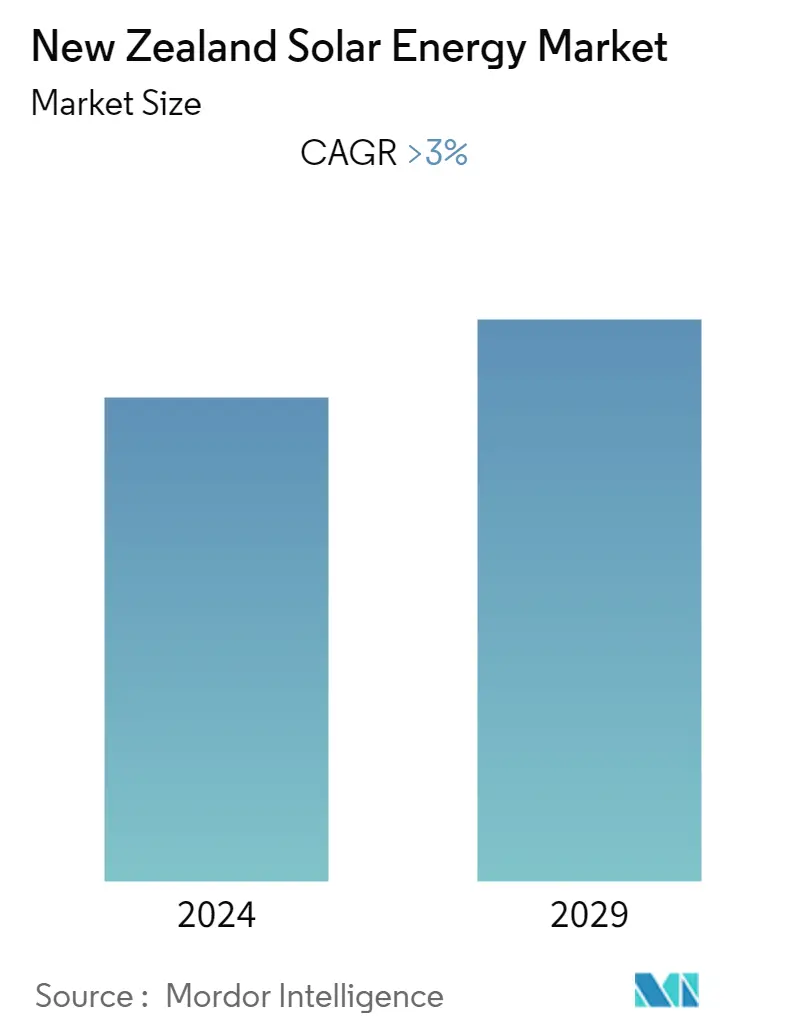Market Size of New Zealand Solar Energy Industry

| Study Period | 2019 - 2029 |
| Base Year For Estimation | 2023 |
| Forecast Data Period | 2024 - 2029 |
| Historical Data Period | 2019 - 2022 |
| CAGR | > 3.00 % |
| Market Concentration | Medium |
Major Players_-_Copy.webp)
*Disclaimer: Major Players sorted in no particular order |
New Zealand Solar Energy Market Analysis
During the time frame of the forecast, the New Zealand solar energy market is expected to register a CAGR of more than 3%.
In 2020, COVID-19 negatively impacted the market. Presently, the market has reached pre-pandemic levels.
- Over the next few years, the solar energy market is likely to grow as the price of solar power technology goes down, installation methods get better, and more people become interested in distributed solar power generation.
- On the other hand, support and investments in other clean energy sources like hydro, geothermal, wind, biomass, etc. are expected to slow the growth of the solar energy market during the forecast period.
- Nevertheless, New Zealand population growth and the rising electrification of heat and transport, the power demand is likely to rise to 70 TWh by 2050. Such a scenario, in turn, is expected to create vital opportunities for solar power players in the future.
New Zealand Solar Energy Industry Segmentation
Solar energy is one of the renewable energies. It is made by converting the energy that is already in the sun.Once the sunlight passes through the earth's atmosphere, most of it is in the form of visible light and infrared radiation. Solar cell panels are used to convert this energy into electricity.
The New Zealand solar energy market is segmented by end-user. By end-user, the market is segmented into residential, commercial and industrial (C&I), and utility. The New Zealand solar energy market covers the size of the market and forecasts for the market. For each segment, market sizing and forecasts have been done based on installed capacity (MW).
| End-User | |
| Residential | |
| Commercial and Industrial (C&I) | |
| Utility |
New Zealand Solar Energy Market Size Summary
The solar energy market in New Zealand is poised for growth over the forecast period, driven by advancements in solar power technology and increased interest in distributed solar power generation. Despite the initial setback due to the COVID-19 pandemic, the market has rebounded to pre-pandemic levels. The utility sector is expected to dominate the market, supported by declining costs of solar generation technology and numerous upcoming solar power projects. The government's ambitious renewable energy targets are likely to attract significant investments in the solar energy industry, with large-scale projects already in the pipeline. However, the growth of the solar market may face challenges from competing clean energy sources such as wind, geothermal, and hydropower, which have established infrastructures and potential for expansion.
The New Zealand solar energy market is characterized by a partially fragmented landscape with key players like Meridian Energy Ltd, JA Solar Holdings, and Trina Solar Co. Ltd. Collaborative efforts, such as the partnership between Far North Solar Farm and Aquila Capital, aim to develop substantial solar PV projects across the country. Similarly, the alliance between Contact Energy and Lightsource BP to co-develop grid-scale solar farms highlights the ongoing commitment to expanding solar capacity. Despite these developments, the market's growth may be tempered by the increasing adoption of alternative clean energy sources, which are expected to play a significant role in New Zealand's energy mix in the coming years.
New Zealand Solar Energy Market Size - Table of Contents
-
1. MARKET OVERVIEW
-
1.1 Introduction
-
1.2 New Zealand Renewable Energy Mix, 2022
-
1.3 Solar Energy Installed Capacity and Forecast in MW, till 2028
-
1.4 Recent Trends and Developments
-
1.5 Government Policies and Regulations
-
1.6 Market Dynamics
-
1.6.1 Drivers
-
1.6.2 Restraints
-
-
1.7 Supply Chain Analysis
-
1.8 PESTLE Analysis
-
-
2. MARKET SEGMENTATION
-
2.1 End-User
-
2.1.1 Residential
-
2.1.2 Commercial and Industrial (C&I)
-
2.1.3 Utility
-
-
New Zealand Solar Energy Market Size FAQs
What is the current New Zealand Solar Energy Market size?
The New Zealand Solar Energy Market is projected to register a CAGR of greater than 3% during the forecast period (2024-2029)
Who are the key players in New Zealand Solar Energy Market?
Meridian Energy Ltd., JA Solar Holdings, New Zealand Solar Power Ltd., Trina Solar Co., Ltd. and JinkoSolar Holding Co., Ltd. are the major companies operating in the New Zealand Solar Energy Market.

